
Australia Pavilion
Beneath the rustic exterior beats the heart of one of the most ambitious audiovisual installations ever conceived.
Text:/ Andy Ciddor
Australia has long taken great pride in its well-presented and well received World Expo pavilions, and after the resounding success of the pavilion in Aichi, Japan, for the 2005 Expo, several of the key players in that project started working on ideas for the Shanghai Expo for 2010 – even while the crowds were still lining up outside Aichi pavilion.
An Expo pavilion may be required to perform many roles, including showcasing a country’s products, its culture, its industrial capacity, its lifestyle, its value as a tourist destination, its desirability as a place to immigrate, its value as a trading partner, or its suitability as a place to invest. An Australian pavilion is intended to fulfill many of these functions and so contains office facilities for trade and business meetings, VIP guest entertainment areas and a substantial component for engaging with the general Expo visiting public.
Think Outside The Square (think!OTS), the company responsible for much of the design and content of the public elements of the 2005 Expo pavilion led a small group who wondered what it might be like if, just for once, a pavilion was designed and constructed around the functions it would perform rather than the more usual process of shoehorning those functions into a clever piece of architecture. Thus the pantomime horse was put before cart, and the think!OTS group, through creative director Pete Ford, was able to convince the Department of Foreign Affairs and Trade, through their tender response, to allow them to develop the design concept for the pavilion.
The concept was further developed into a piece of clever architecture by Wood/Marsh architects and engineered and constructed through a partnership with Bovis Lend Lease, the general contractor for the project. At each stage in the journey think!OTS was retained as the designers and developers of the pavilion’s content and in turn it led a team of contractors who conceived, wrote, designed, constructed, installed, commissioned, as well as operate and maintain the pavilion’s attractions for the six-month run of Expo 2010.
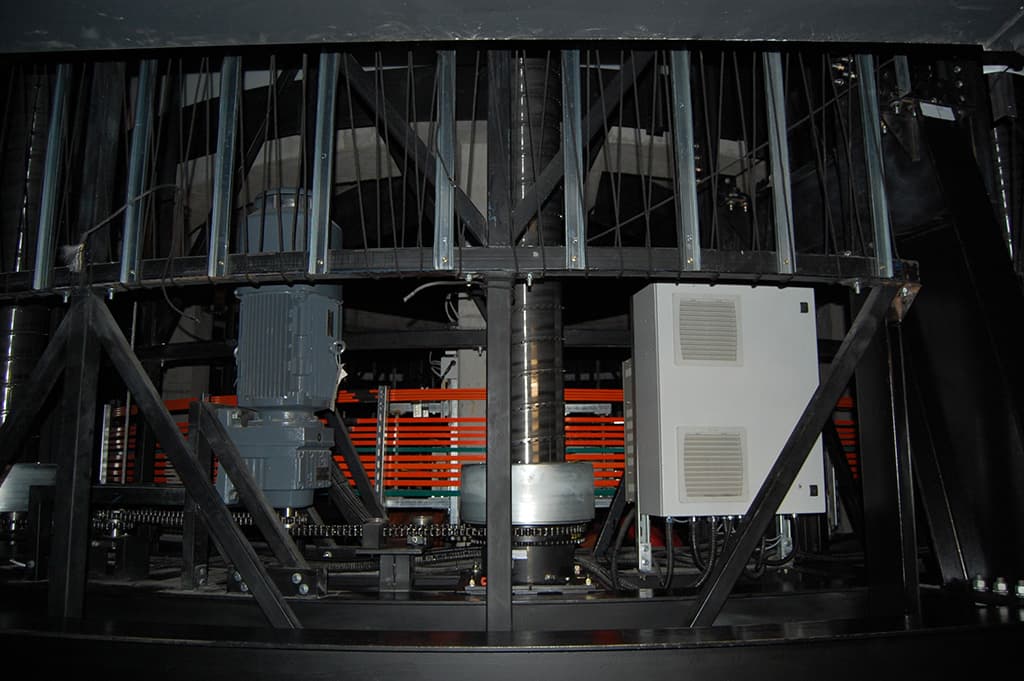
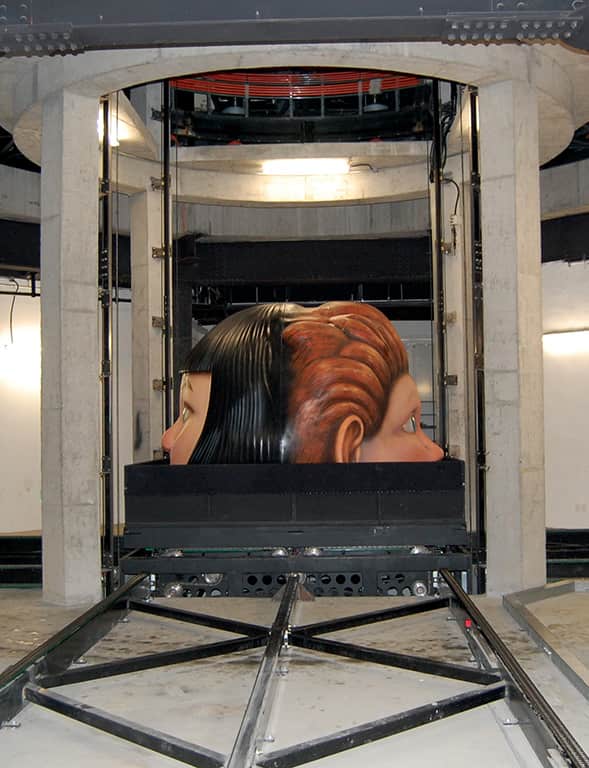
RUSTED ON AUSSIES
You would have to have been trapped in a very deep cave to have missed the fact that this pavilion is constructed from a special type of rust-forming steel which weathers to a red ochre and through its organically-curved slab shape echoes the form of Uluru.
The audience involvement in the Shanghai pavilion was conceived as operating along the lines of a three-act play: Act 1 introduces the characters and sets up the location for the action, Act 2 contains the main dramatic elements of action and conflict and, finally, Act 3 brings the resolution of the conflict and the transformation of the characters. As played out in Australia’s Expo 2010 pavilion, Act 1, Journey, is an introduction to Australia: its geography, people and history; Act 2, Discover, is the main drama, telling the story of contemporary Australian life; and Act 3, the denouement, Enjoy, is the opportunity for the visitor to connect personally with their new-found friend Australia by buying its products, clothes, food and souvenirs, while being entertained by Australian performers. Although each of these sections has been given titles for public consumption, they continue to be referred to as Acts 1, 2, and 3 by most people on the pavilion team.

ACT ONE: JOURNEY
On entering the pavilion, visitors walk through a 160m curving cylindrical ramp that passes in and out of the pavilion walls, taking them on a journey through six introductory experiences on their way to the main auditorium.
An acknowledgement of Australia’s immense indigenous history and culture, Bedrock combines elements of indigenous art from Maningrida in the NT with an evocative 12-channel soundscape. In addition to the QSC AD-S52T ceiling speakers mounted over this area, several of the tall cylindrical ‘carvings’, reminiscent of oversize didgeridoos, are constructed from very modern materials to conceal speakers delivering some channels of the soundscape.
Sisters is a series of 21 short documentary pieces by Annie Venables about insprirational women in Australia and China. The aim is to demonstrate our commonalities as people and as countries through the stories of these inspirational women – “what we share”. These videos are played back from a Coolux Pandoras Box and projected on to the surface of the cylindrical tunnel with four Christie DS+ 6K-M SXGA+ projectors using the Coolux system to correct the image for the geometry of the tunnel surface. The audio comes from more of the QSC AD-S52Ts that are used throughout the pavilion.
Known to the Expo team by its working title of ‘222’ for reasons soon to be apparent, Nation is a far-from-serious look at the 222 years of Australia’s history since the arrival of the first European settlers. This section takes the unusual form of a 22.2m-wide diorama-style display (think: Myer at Christmas) accompanied by a 24-channel soundscape (probably in 22.2 format… guffaw). The display features tableaux of caricatured models of significant people, places and events in recent Australian history.
Land is a complex sculptural structure in a shape resembling a wave rising up and curling over the visitors as they pass down its 16m length. Created from acrylics, steel and foam with an embedded custom LED screen, this section is intended to provide comparisons between China and Australia through facts relating to population.
The journey through the Act 1 tunnel ends with People, a photo montage of Australians at work and play across the country. During that 160m journey from the entrance to the doors of the Act 2 auditorium our visitors have passed video screens carrying 128 different VGA feeds – a not inconsiderable feat of video distribution.

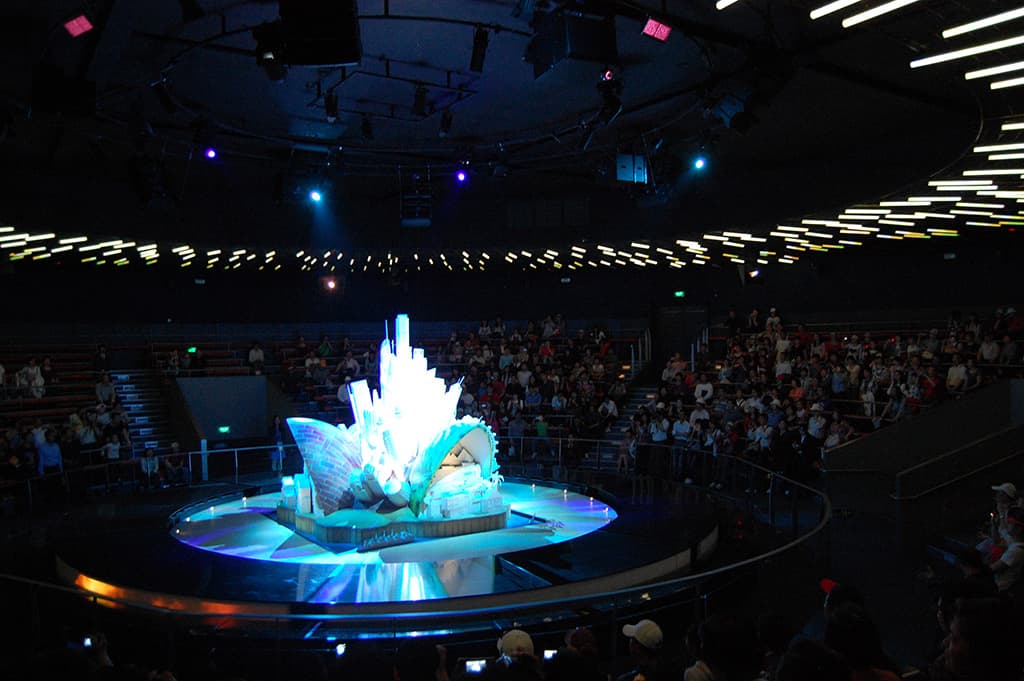
ACT TWO: DISCOVER
While the rest of the world has been getting excited about immersive projection theatres – varying from partial wrap-around to full enclosure, in formats ranging from square and polyhedral, to cylindrical and spherical geometries (see our Expo pavilion rundown in the pages that follow) – Act 2 turns that concept completely inside out. Rather than an audience staring upwards and outwards at the encompassing screens, this show concentrates on a more physically immediate and engaging format. The show is ‘performed’ in a 1000-seat arena-style circular auditorium, where the audience faces in towards centre stage and across to the rest of the audience. On entry, the focus is on a central circular stage, pre-set with a patch of Australia’s signature beach sand, complete with sandcastles, buckets and spades. The audience’s expectations are clearly being set up for a live show.
What they get is a projected video presentation, combining live action footage with a cast of computer-generated characters as they learn about life in contemporary Australia. What makes this presentation more dynamic and so significantly different from anything else at Expo is the continuously-rotating cylindrical screen that rises up through the floor to enclose that beach scene. The cylinder is split into six sections that can be independently raised and lowered to any level, from flush with the floor to its full 5m height. The inner surfaces of alternate segments are also custom-built, constant pixel pitch 25mm LED screens from Shenzen Aoto Electronics. Projection on the outer surface of the cylinder is from seven Christie Roadster S+20Ks, fed from a Coolux Pandoras Box system to compensate for the geometry of both the projection angle and the cylindrical screen surface. The Pandoras Box also provides moving masking to ensure the images are only projected onto visible sections of the rotating and elevating screen segments. To ensure the masking corresponds to the screen segments’ actual positions rather than some hypothetical timecode-synchronised points, real-time positional information is fed from 11 shaft encoders on the lift and rotation system.
The screens are mounted on a 10m-diameter, rim-driven, ring-shaped dolly which runs constantly from pre-show start-up each morning until the close of the pavilion each night. All mechanical drive, movement control and video drives for the screen system are on board the dolly. Its only connections with the outside world are two three-phase slip-ring power feeds, one for mechanical drives and one for electronics, and a bi-directional radio link that carries all video, command and control data. Although it is recognised that a radio link is less reliable than cable, it was considered that any high-bandwidth data slip-ring system, while being substantially more expensive, would prove no more dependable or easy to maintain for the duration of the run.
Around the ceiling of the auditorium, radiating out from the stage, are 17,280 individually-addressed colour-changing LED Happy Tubes, driven by around 12,000 channels of DMX (a Coolux media server outputs ArtNet, which is converted to DMX via dozens of Pathway Pathport devices). In addition to doubling as low-energy house lighting, the tubes provide a range of opportunities for extending the look of the screen material and involving the audience space in the performance. A Jands Vista console looks after all the other lighting, run from dozens of LSC dimmers.
The elevation of the screen is via a pair of Gala Systems Spiralifts per segment. Spiralifts were selected for their simplicity, stability and compactness, but turned out not to have the speed ultimately required for the show. To overcome this shortcoming, the Spiralift was used as the actuator for a classic double-purchase lift system, which may require double the thrust, but which produces double the speed.
The centrestage platform is actually a motorised stage lift in the tradition of the operatic wagon-stage. Four wagons with three-dimensional scenic elements are stored in a motorised, cross-shaped rail network beneath the stage and moved onto the stage lift and raised into position when masked by the screen. In line with all other departments, service and scheduled preventive maintenance is conducted on the mechanical system overnight.

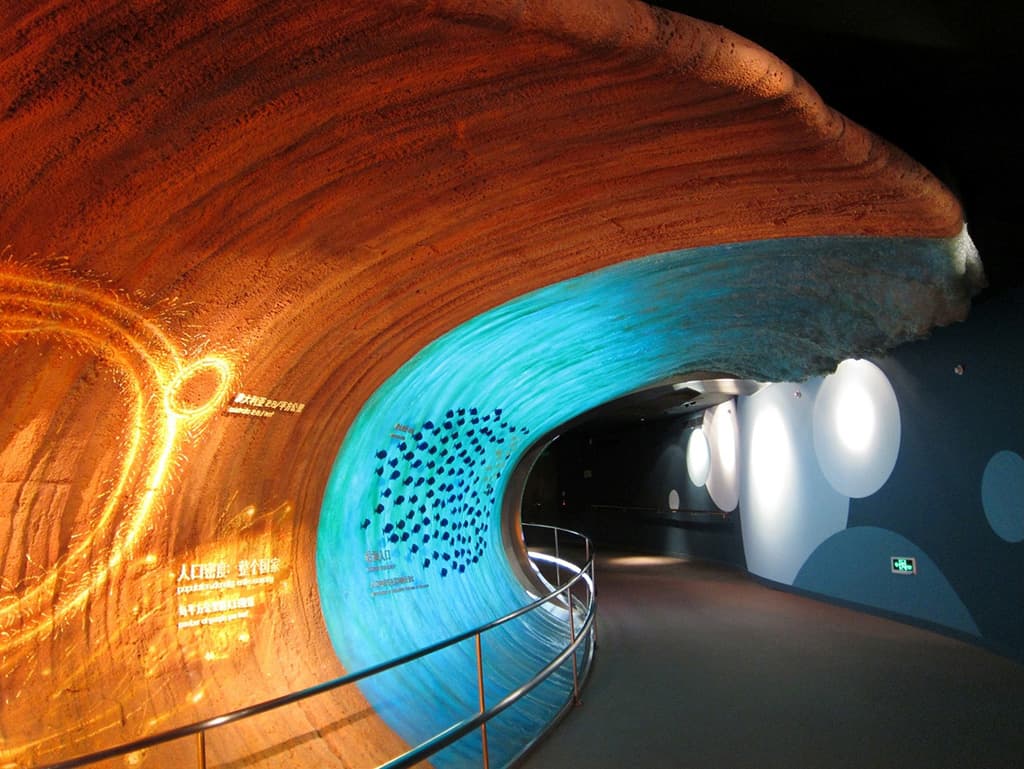
As the visitors to the pavilion are predominantly Chinese, the 24-channel soundtrack played over the PA is voiced in Mandarin (with English subtitles), with English and Chinese voice tracks available via a Creator wireless infrared system for the hearing impaired. The 360° main FOH PA system is a six-hang of 4 x QSC ILA 2082 WideLine line arrays and four QSC WL118 flying subs, with 12 x QSC AD-S82H providing front fill. Surround effects are provided through 15 x QSC AD-S82H, spaced equally around the rear wall of the auditorium. Along with the rest of the pavilion, the system is powered by QSC’s Audio CX series multi-channel amplifiers.
The theatre with its three vomitory entrances is designed for rapid audience turnover after each nine-minute show. The optimum throughput for the show is 40 x 1000-person full-houses per operational day, but when I visited on only the second day of Expo, it was working substantially below that capacity.
By the 22nd of July (Expo day 83), audience management procedures had geared up to the behaviour patterns of the audiences, with punter throughput reaching above 53,000 on busy days. By the end of that day, a total of 3,713,472 people had visited the Australian pavilion, while 30,826,700 had visited Expo as a whole.
ACT THREE: ENJOY
The final stage of the visitor’s journey is the three-storey atrium space which houses the food, beverage and souvenir concessions and which hosts a series of Australian acts to entertain the punters while they spend their hard-earned yuan. Hanging from the ceiling are eight huge organically shaped pods filled with LED illuminated flowers in the shapes of the official flora of the states and territories.
The ceiling also has a lighting grid and a substantial rigging system supplied by Omotion for the aerial acts which are part of the regular roster of entertainment that is supplemented by a regular program of visiting performers. The PA for the audience area of the atrium is QSC ILA WideLine 2082 line array boxes and WL118 flown subs.
While everything in the pavilion is designed to handle the substantial hammering of 14 hours of continuous operation, every day for the 184 days of Expo, this is not a permanent installation. At the end of the six-month run, the circus folds its tents and the entire pavilion will be disassembled and the site cleared and rehabilitated. Meanwhile, if you were to hang around the pavilion for very long you would probably overhear the discussions about the one they want to build for Expo 2015 in Milan.
DRAMATIS PERSONAE
- Pete Ford: Creative Director, Think OTS
- Tim McMahon: Project Director, Think OTS
- Angus Wippell: Project Director Bovis Lend Lease (General Contractor)
- Graeme Woolacott: Construction Manager Bovis Lend Lease (General Contractor)
- Andrew Dibble: Producer/Partner, Think OTS
- Anne Sykes: Executive Producer, Think OTS
- Paul Van Der Ent: Executive Technical Director, Wizard Projects
- Anthony Cornish: Act 2 Mechanical Design Engineer, Connell Wagner
- Glenn Harris: Act 2 Mechanical Design & Construction Engineer, Harris Movement Engineering
- Dave White: Art Director
- Bob Brunton: Exhibit Designer
- Phil Lethlean: Lighting Designer
- Richard Grenfell: Lighting Programmer
- Tony Russo: DSP Design & Audio System Engineer, TAG
- Brian Lawrence: Audio Producer, Brian Lawrence Sound
- Dale Cornelius: Audio Composer



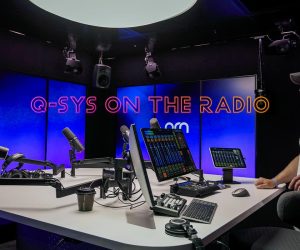




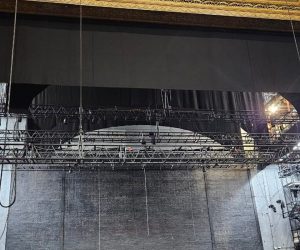


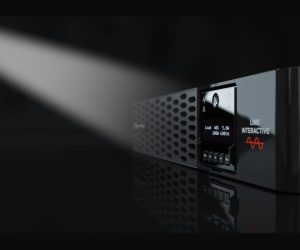



RESPONSES